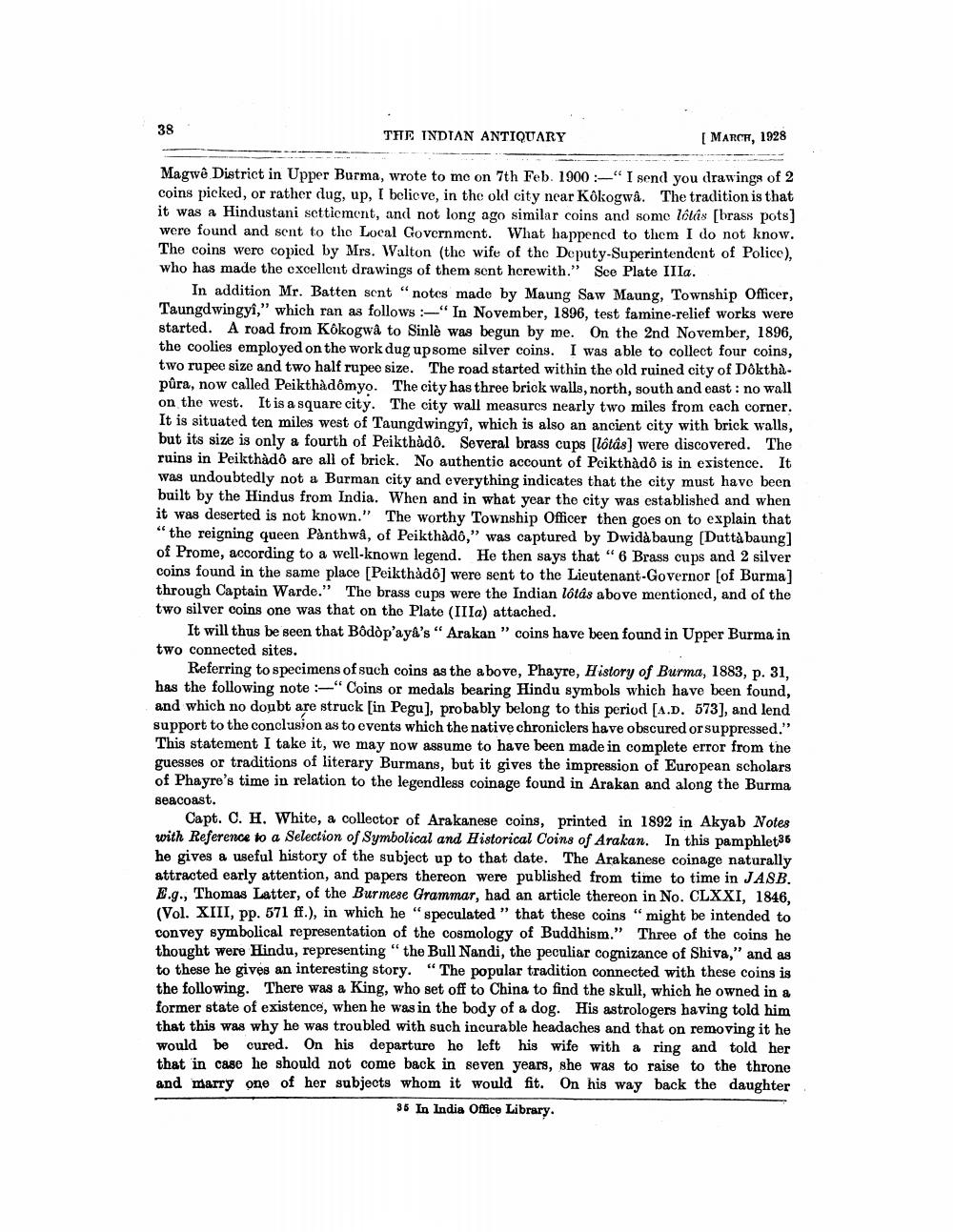________________
38
THE INDIAN ANTIQUARY
[ MARCH, 1928
Magwê District in Upper Burma, wrote to me on 7th Feb. 1900 -" I send you drawings of 2 coins picked, or rather dug, up, I believe, in the old city near Kökogwa. The tradition is that it was a Hindustani setticment, and not long ago similar coins and some lótás (brass pots] were found and sent to the Local Government. What happened to them I do not know. The coins were copied by Mrs. Walton (the wife of the Deputy-Superintendent of Police), who has made the excellent drawings of them sent herewith." See Plate IIIa.
In addition Mr. Batten sont "notes made by Maung Saw Maung, Township Officer, Taungdwingyi," which ran as follows :-"In November, 1896, test famine-relief works were started. A road from Kókogwâ to Sinlè was begun by me. On the 2nd November, 1896, the coolies employed on the work dug up some silver coins. I was able to collect four coins, two rupee size and two half rupee size. The road started within the old ruined city of Dokthi. pûra, now called Peikthàdômyo. The city has three brick walls, north, south and east: no wall on the west. It is a square city. The city wall measures nearly two miles from each corner. It is situated ten miles west of Taungdwingyî, which is also an ancient city with brick walls, but its size is only a fourth of Peikthàdô. Several brass cups [lôtás) were discovered. The ruins in Peikthàdô are all of brick. No authentic account of Peikthàdô is in esistence. It was undoubtedly not a Burman city and everything indicates that the city must have been built by the Hindus from India. When and in what year the city was established and when it was deserted is not known." The worthy Township Officer then goes on to explain that “the reigning queen Panthwâ, of Peikthàdo," was captured by Dwidà baung (Duttà baung] of Prome, according to a well-known legend. He then says that “6 Brass cups and 2 silver coins found in the same place [Peikthådo) were sent to the Lieutenant-Governor (of Burma] through Captain Warde." The brass cups were the Indian lótás above mentioned, and of the two silver coins one was that on the Plate (IIIa) attached.
It will thus be seen that Bodòp'aya's "Arakan " coins have been found in Upper Burma in two connected sites.
Referring to specimens of such coins as the above, Phayre, History of Burma, 1883, p. 31, has the following note :-" Coins or medals bearing Hindu symbols which have been found, and which no doubt are struck [in Pegu), probably belong to this period [A.D. 573], and lend support to the conclusion as to events which the native chroniclers have obscured or suppressed." This statement I take it, we may now assume to have been made in complete error from the guesses or traditions of literary Burmans, but it gives the impression of European scholars of Phayre's time in relation to the legendless coinage found in Arakan and along the Burma seacoast.
Capt. C. H. White, a collector of Arakanese coins, printed in 1892 in Akyab Notes with Reference to a Selection of Symbolical and Historical Coins of Arakan. In this pamphlet36 he gives a useful history of the subject up to that date. The Arakanese coinage naturally attracted early attention, and papers thereon were published from time to time in JASB. E.g., Thomas Latter, of the Burmese Grammar, had an article thereon in No. CLXXI, 1846, (Vol. XIII, pp. 571 ff.), in which he "speculated" that these coins "might be intended to convey symbolical representation of the cosmology of Buddhism." Three of the coins he thought were Hindu, representing "the Bull Nandi, the peculiar cognizance of Shiva," and as to these he gives an interesting story. "The popular tradition connected with these coins is the following. There was a King, who set off to China to find the skull, which he owned in a former state of existence, when he was in the body of a dog. His astrologers having told him that this was why he was troubled with such incurable headaches and that on removing it he would be cured. On his departure he left his wife with a ring and told her that in case he should not come back in seven years, she was to raise to the throne and marry one of her subjects whom it would fit. On his way back the daughter
36 In India Office Library.




